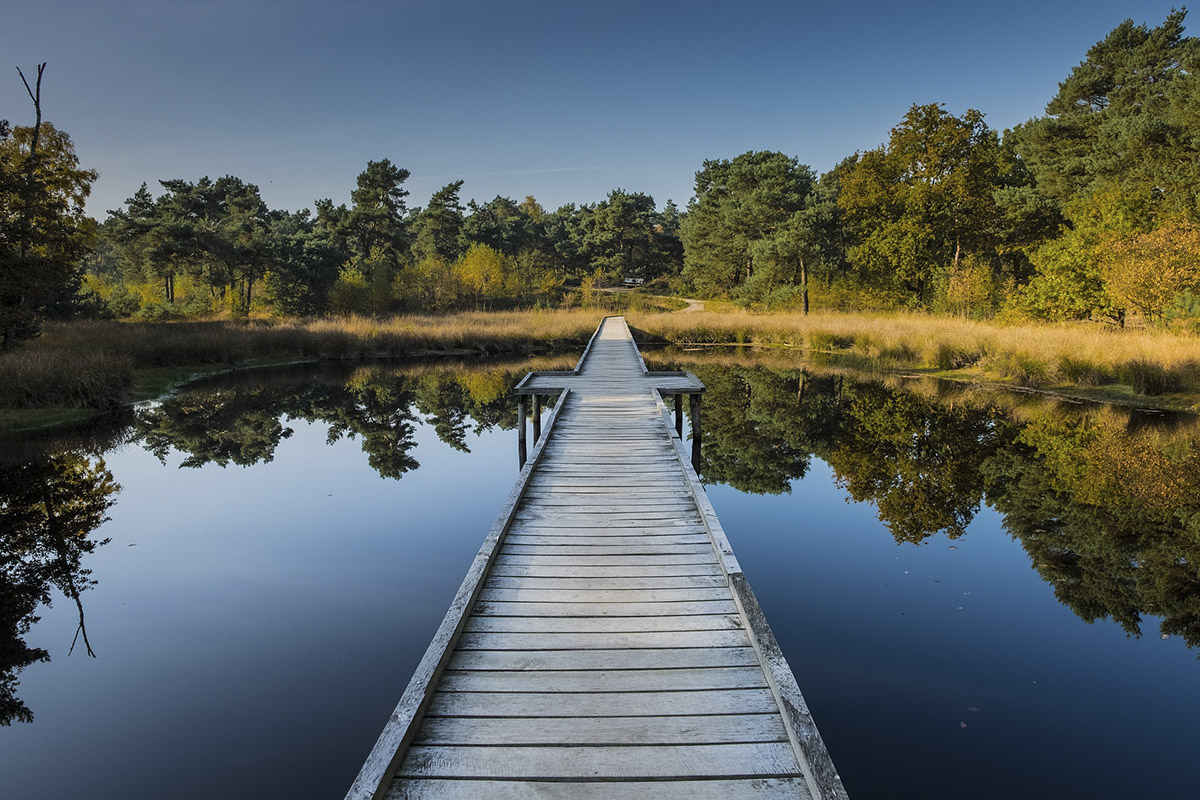Green Netherlands’ TOP 5 national parks
TEXT: DANA MARIN

Path over the vivid blue waters in Maasduinen. Photo: Alfred Derks
Despite its small size, the Netherlands is home to 21 unique national parks, each one telling a story of how the country developed and helping preserve nature and biodiversity. We invite you to expand your bucket list with five of the most beautiful Dutch national parks. Grab a map and start planning your next nature outing!
Veluwezoom – Gelderland Province
The Veluwezoom is the oldest Dutch national park and one of the largest, spanning 5,000 hectares. Its landscape is defined by rugged woodlands, heathlands, drift sand and farmland. The Veluwezoom is inhabited by a variety of flora and fauna, including boars, deer and Scottish Highlanders.
What makes this park so unique is its picturesque and hilly landscape – a stark contrast to the otherwise flat Netherlands. These hills are push moraines sculpted during the Saalian Glaciation some 150,000 years ago. Standing on the highest one, the Posbank, at 90 metres above sea level, you can see all the way to Germany on a clear day. In late summer, the hills are covered in purple heather, creating a magical view on misty mornings and attracting droves of photographers in search of the perfect shot. In autumn, the lush forests resound with the bellowing of the male deer looking for a mate.
On the southern edge of the park, there are a few country estates that can be visited, among them Heuven and Beekhuizen, located along the Herikhuizen walking route.

A misty morning in Veluwezoom. Photo: Jonne Laagland Winder
Dunes of Texel
The Dunes of Texel National Park is situated on the island of Texel in the north of the Netherlands. A popular holiday destination for the Dutch and for many German tourists who want to spend a few days by the sea, Texel is dotted with only a few villages and boasts a serene landscape with grazing sheep, sand dunes and a beautiful lighthouse. The Dunes of Texel covers the entirety of the island’s dunes and woodlands – from the southernmost tip at De Hors to the dunes close to the lighthouse at the island’s most northerly point. Heaths, marshes, beaches and both freshwater and saltwater waterways are also part of this splendid national park. For birdwatchers, the area is a paradise as it is home to some 400 bird species.
You can cycle or hike on the park’s many trails, admiring the quickly changing flora and making an occasional stop to dip into the sea. And, if you’re lucky, you can even spot seals resting in the sun! The sunsets are impressive and can be admired from the vast beaches or from one of the many beach restaurants.

Sumer vegetation in the Dunes of Texel Park. Photo: Dana Marin
The Biesbosch – North Brabant
The Biesbosch National Park is a spectacular nature conservation area and one of the last examples of freshwater tidal wetlands in Northwest Europe, where you can observe the ebb and flow. Best explored by boat or canoe, the park is a maze of rivers and creeks peppered with tiny islands. The view is awe-inspiring, and visitors are encouraged to make stops along the way to explore the islands on foot. You can wander through the thick willow forests teeming with wildlife, and you might even spot pine martens, deer or beavers. The Biesbosch counts over 300 beavers and 100 dams. Keep an eye out for gnawing marks on trees left by these resident rodents!

Swans in the Biesbosch. Photo: Micheile Henderson
De Alde Feanen – Friesland
With its natural splendour and diverse wildlife, De Alde Feanen is a picturesque wetland area in the heart of Friesland and highly popular among nature enthusiasts and birdwatchers. While walking through De Alde Feanen, you’ll come across 450 different kinds of plants and will spot myriad birds such as the black-tailed godwit and the bearded reedling; at least 100 species call this landscape home. The park can be explored by bike or on foot, and there are several marked trails that lead through the different habitats within the park.
The main attraction of the park is its network of canals and lakes. You can book a guided tour through the canals or rent a canoe or a rowboat to discover the unique landscape of the park at your leisure. And for a touch of culture, step back in time by visiting the monumental windmills dating back to the 18th century.
The Maasduinen – Limburg
At the Maasduinen National Park, you’ll find the longest river dune belt in the Netherlands. The landscape is a sloping ribbon of dunes, overgrown forests, patches of heathland, fields, shifting sands and gleaming fens lining the east bank of the river. One of the most fascinating residents of these southern dunes is a small and robust sand lizard with a thick tail. You’ll also find buzzards, beavers, butterflies and the non-venomous smooth snake.
During the spring and autumn, the Maasduinen attracts cranes on their migratory journeys. While walking along the sandy paths and enjoying the fresh air, you may just find yourself in the company of goats, sheep and Galloway cattle.
De Maasduinen counts 17 marked paths, including a few that are wheelchair accessible. A great tip is to follow the routes that take you around the Reindersmeer (an artificial lake created by large-scale sand extraction). You’ll be mesmerised by the vivid blue colour of the crystal-clear waters. And if you want to experience this magical place to the fullest, pitch up your tent at one of the park’s campsites. There’s plenty to merit a longer stay!

Meandering canals in De Biesbosch. Photo: Stan Versluis
Subscribe to Our Newsletter
Receive our monthly newsletter by email





